Rattlesnakes are a group of venomous snakes belonging to the genus Crotalus and Sistrurus. They are characterized by a distinctive rattle at the end of their tails, which they use as a warning signal to potential threats. Rattlesnakes are primarily found in the Americas and are known for their potent venom and heat-sensing pit organs located between their eyes and nostrils.
Here’s a look at the 21 most interesting types of rattlesnakes in the world.
1. Eastern Diamondback Rattlesnake
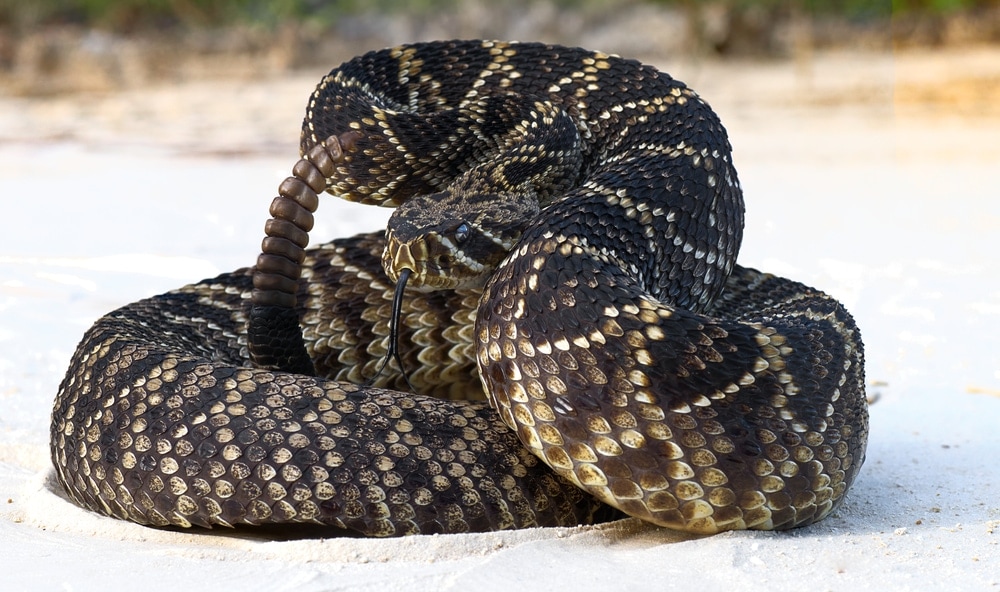
Found only in the southeastern United States, the eastern diamondback rattlesnake (Crotalus adamanteus) is a large snake that’s known for its deadly venom.
The eastern diamondback is one of the heaviest venomous snakes in the world with an average weight of approximately 34 lbs (15 kg). The body usually has a mottled brown and yellow coloration as well as a distinct pattern of about 20 to 35 black-colored diamonds on its back.
The eastern diamondback is currently listed as a species of least concern by the IUCN (International Union for Conservation of Nature). However, the species has been extirpated from many states, including Louisiana, and it is a candidate for the US Fish and Wildlife Service’s Endangered Species List.
2. Western Diamondback Rattlesnake

The western diamondback rattlesnake (Crotalus atrox) is one of the best-known venomous snakes in North America. It lives only in the south-central and southwestern parts of the United States and northern Mexico.
Known for its distinctive dusty gray color and black diamond-shaped splotches, the western diamondback is an iconic species within the desert regions of North America. It primarily feeds on kangaroo rats, prairie dogs, jackrabbits, voles, and other small- to medium-sized mammals.
Like its close cousin, the eastern diamondback, the western diamondback is listed as a species of least concern. However, the western diamondback has long been targeted by humans in the area as a pest species.
3. Mexican West Coast Rattlesnake

Aptly named, the Mexican west coast rattlesnake (Crotalus basiliscus) is a large serpent found along the western coastline of Mexico.
It is primarily found between the states of Sonora and Michoacán, and its primary habitat is in grasslands and other scrub ecosystems. The Mexican west coast rattlesnake is known for its highly toxic venom, though fatal attacks on humans are rare.
The Mexican west coast rattlesnake is listed as a species of least concern, owing primarily to its wide distribution throughout coastal Mexico. However, it is at threat of habitat loss to agriculture and it is sometimes hunted by humans.
4. Santa Catalina Rattlesnake

The Santa Catalina rattlesnake (Crotalus catalinensis) is a rare pit viper that’s found only on Isla Santa Catalina in the Gulf of California. However, it is not to be confused with the southern Pacific rattlesnake, which is found on Santa Catalina Island in California’s Channel Islands.
If there’s one thing that makes the Santa Catalina rattlesnake unique, it’s the fact that it doesn’t actually have a rattle. It has a rattle-like structure on the end of its tail, but it can’t actually make a rattling sound.
The Santa Catalina rattlesnake is currently listed as critically endangered and its population is declining. It is at risk of extinction due to habitat loss and predation by introduced species, such as feral cats.
Read Also: Snakes (venomous snakes): Description, Damages Caused, Control and Preventive Measures
5. Horned Rattlesnake
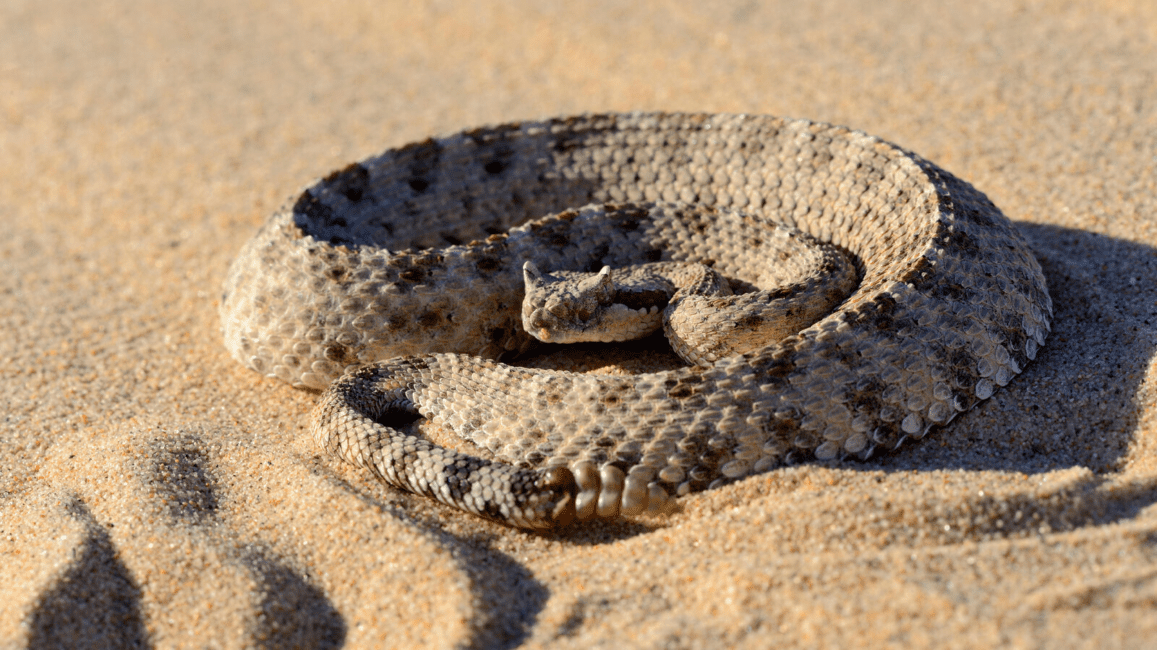
Sometimes called the sidewinder, the horned rattlesnake (Crotalus cerastes) is a small pit viper that lives in the southwestern US and northwestern regions of Mexico.
The horned rattlesnake’s defining feature is its characteristic horns, which are actually just a set of supraocular scales. It’s believed that these horns might provide shade and protection for the snake’s eyes.
This species lives primarily in desert environments and you can sometimes see sidewinder tracks left behind in the sand. In fact, the horned rattlesnake uses a unique form of locomotion called sidewinding where it pushes its body sideways across sandy slopes.
6. Arizona Black Rattlesnake
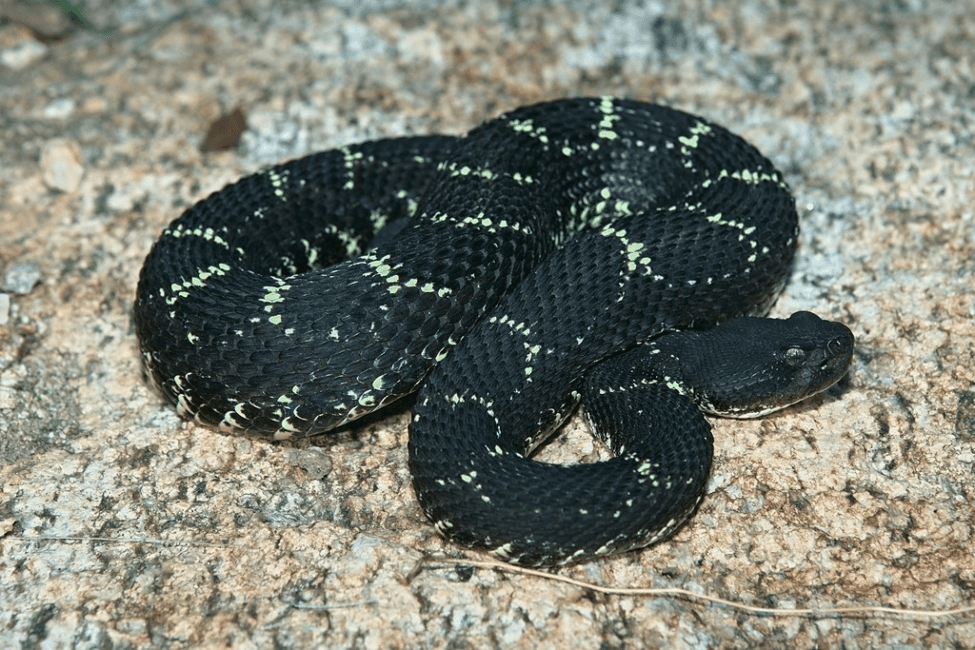
The Arizona black rattlesnake (Crotalus cerberus) is an easily identifiable serpent that lives only in the US state of Arizona. It’s primarily found in and around the San Francisco Mountains in the central part of the state.
This snake gets its name from the fact that it is nearly all black in color, save for a few white stripes, when fully grown. That said, the snake actually has the ability to change color, much like a chameleon, but it’s not clear why or how this happens.
The Arizona black rattlesnake is not listed by the IUCN, but researchers believe that it is quite rare. It lives primarily in high-elevation locales in remote parts of Arizona, so it is difficult to study.
7. Northwestern Neotropical Rattlesnake
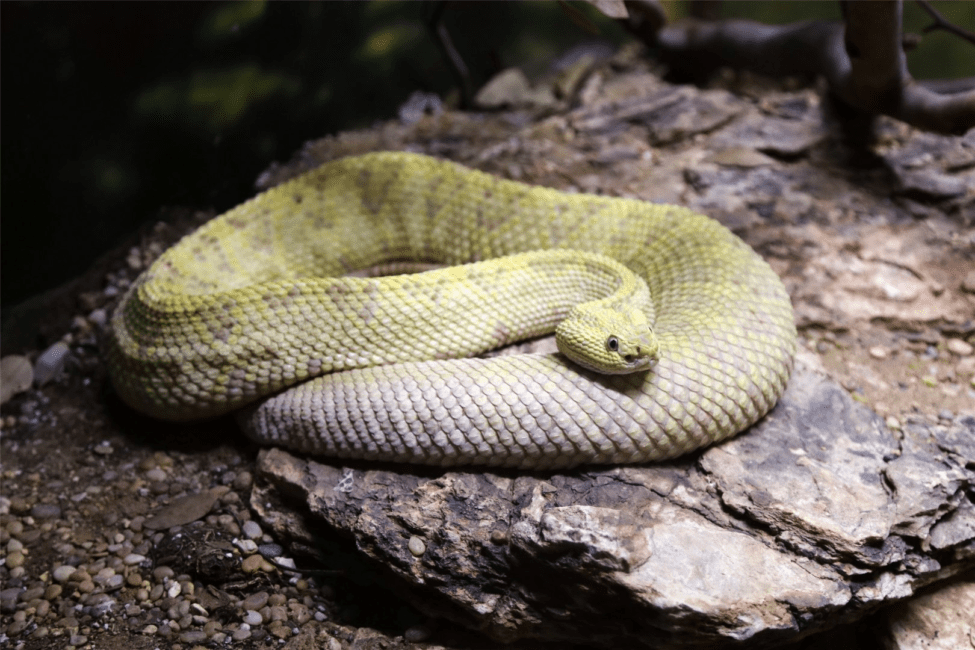
Also called the middle American rattlesnake, the northwestern neotropical rattlesnake (Crotalus simus) is a highly venomous pit viper that lives primarily in southern Mexico and Central America.
It has a lightly colored set of scales with a series of distinct brown-colored triangles running down its back. However, its most characteristic feature is its flat nose, which helps differentiate it from other snakes in the area.
Researchers believe that the northwestern neotropical rattlesnake was highly revered by the ancient Mayans. It remains an important species in the culture of many Maya communities to this day.
8. South American Rattlesnake
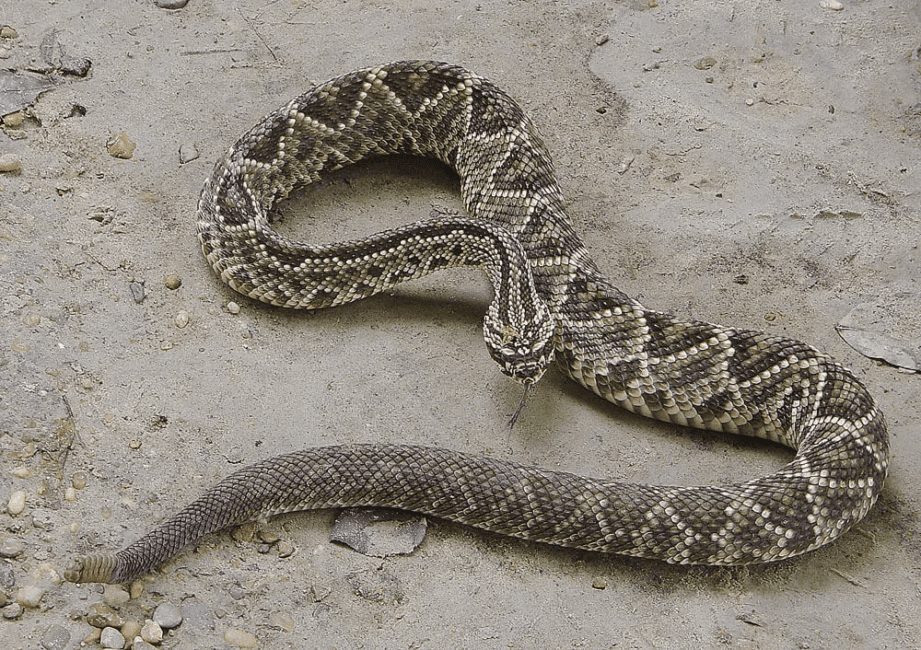
The South American rattlesnake (Crotalus durissus) and its seven recognized subspecies are the most widely distributed rattlesnakes in South America.
Also known as the cascabel rattlesnake, this species is found nearly everywhere in the northern part of South America except for the Andes Mountains. It primarily lives in semi-arid environments, including in scrublands, grasslands, and dry forests, but you can also find it in more tropical parts of the continent.
Due to its wide distribution, the South American rattlesnake is listed as a species of least concern and it doesn’t have any particularly big threats to its long-term survival.
9. Timber Rattlesnake

Found primarily in the eastern United States, the timber rattlesnake (Crotalus horridus) is a common sight in woodland areas that stretch from Minnesota to New Hampshire.
The timber rattlesnake is a relatively small pit viper with an average weight of no more than about 3 lbs (1.4 kg). It’s fairly easy to identify due to its light brown coloration and distinctive banded pattern of darkly colored scales.
Although it has been extirpated in many parts of its range, the timber rattlesnake is listed as a species of least concern by the IUCN due to its wide distribution. It is a protected species in much of the Appalachians and it is classified as threatened in many states.
10. Tiger Rattlesnake

Boasting a distinctive set of striped scales, the suitably named tiger rattlesnake (Crotalus tigris) is a highly venomous serpent that lives in northwestern Mexico and the southwestern United States.
For the most part, the tiger rattlesnake lives in rocky areas, steep canyons, and arid scrublands. They prefer to feed on small mammals, like kangaroo rats, but they’ve also been observed eating spiny lizards.
The tiger rattlesnake is currently listed as a species of least concern, however, it is at threat of habitat loss due to the increase in agriculture throughout its range. While it’s not widely hunted, its skin is commonly collected and sold in tourist souvenir shops in much of the desert southwest.
11. Ridge-nosed Rattlesnake
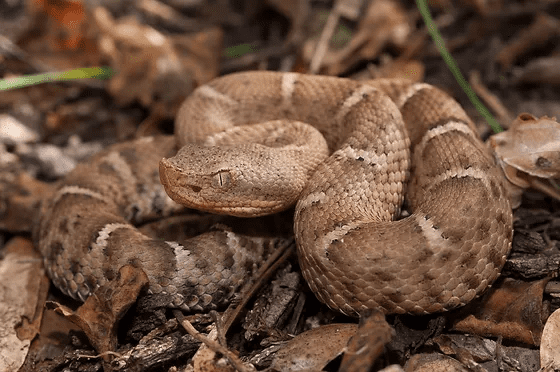
The ridge-nosed rattlesnake (Crotalus willardi) is a small pit viper that lives in southern Arizona, southern New Mexico, and northwestern Mexico.
It primarily inhabits high-elevation locales that offer respite from the heat and aridity of the Sonoran Desert. In fact, the ridge-nosed rattlesnake is rarely found outside of the Madrean Sky Islands ecozone, which exists at the highest elevations of the major mountain ranges in the region.
The ridge-nosed rattlesnake is actually the state reptile of Arizona. It is listed as a species of least concern, however, more research is needed to understand the snake’s current population trends. In particular, the New Mexico subspecies of the ridge-nosed rattlesnake is listed as a threatened species by the US Fish and Wildlife Service.
12. Prairie Rattlesnake

One of the most widely distributed rattlesnakes in North America, the prairie rattlesnake (Crotalus viridis) is a pit viper whose range extends as far south as Mexico and as far north as southern Canada. It primarily lives in the Great Plains region and in the US Rocky Mountains.
The prairie rattlesnake usually boasts a light brown coloration, which helps it blend in well with the grass and brush of its native habitat. While the prairie rattlesnake generally spends its life on the ground, it will sometimes climb trees for shelter in harsh conditions.
There are two recognized subspecies of the prairie rattlesnake: the nominate subspecies, Crotalus viridis viridis, and the Hopi rattlesnake (Crotalus viridis nuntius). The Hopi rattlesnake lives primarily in Arizona and New Mexico and it is generally smaller than the other subspecies.
13. Uracoan Rattlesnake

The Uracoan rattlesnake (Crotalus vegrandis) is one of the least-studied rattlesnakes in the world. It lives only in Venezuela and it is primarily found near the municipality of Uracoa, which is located in the northeastern part of the country.
Although it isn’t well-studied, the Uracoan rattlesnake is fairly easy to identify based on its predominantly sandy-brown coloration that’s interspersed with speckles of white scale pattern. This coloration helps it blend in well with its native habitat, which is a savannah-like region that’s situated just outside the Orinoco Delta.
Little is known about the Uracoan rattlesnake’s conservation status, but human development in its geographically small habitat is likely contributing to the species’ decline.
14. Aruba Rattlesnake

Appropriately named, the Aruba rattlesnake (Crotalus unicolor) is a pit viper that’s endemic to the island of Aruba, which is located just off the coast of Venezuela. However, some researchers consider it to be a subspecies of the South American rattlesnake.
Aruba rattlesnakes can be many different colors, though pink and brown are the most common. The coloration of the snake helps it blend in well with the color of the soils in its native environment, which is primarily the scrub and desert regions of the southeastern part of Aruba.
Even though it’s not listed by the IUCN (partially because of a dispute among taxonomists about how to best classify it), the Aruba rattlesnake is at threat of extinction due to human encroachment and habitat loss. Researchers believe that there are fewer than 300 individual Aruba rattlesnakes left in the wild.
Read Also: The Appearance and Features of Water Snakes
15. Panamint Rattlesnake

The Panamint rattlesnake (Crotalus stephensi) is a medium-sized pit viper that lives primarily in the southern and central parts of Nevada and in the Owens Valley/Payahǖǖnadǖ region near Death Valley. Its common name comes from that of the Panamint Range, which is one of the major mountain ranges in the northern Mojave Desert.
Like many other desert-dwelling serpents, the Panamint rattlesnake has a greyish-brown coloration that helps it blend in with the rocks and sand in its habitat. The Panamint primarily lives in rocky areas at higher elevations, but it ventures down into the lower elevations during the cooler months of the year.
The Panamint rattlesnake isn’t currently listed by the IUCN. However, this is because the Panamint rattlesnake was considered a subspecies of the speckled rattlesnake until 2007. More research is needed to fully understand its conservation status.
16. Mojave Rattlesnake

One of the most iconic species of the desert southwest, the Mojave rattlesnake (Crotalus scutulatus) is a highly venomous serpent that lives in the greater Mojave Desert region.
Of all its characteristics, the Mojave rattlesnake is arguably best known for its highly potent venom. Its venom is actually a mix of both a hemotoxin and a neurotoxin, so it can cause a range of issues, such as respiratory failure and muscle weakness.
Thankfully, Mojave rattlesnake bites are not common and fatal bites are even rarer. Additionally, there is an antivenin called CroFab that’s highly effective against Mojave rattlesnake venom. Either way, it’s best to give these amazing rattlesnakes quite a bit of distance if you see one on the trail.
17. Red Diamond Rattlesnake

The red diamond rattlesnake (Crotalus ruber) is a large pit viper that lives exclusively on the Baja California Peninsula and the southernmost extent of the US state of California.
As its name suggests, the red diamond rattlesnake has a scale pattern that features large diamonds along its back. That said, it’s more brown than red in color, but it does have a distinctive black and white striped pattern on the base of its tail.
Red diamond rattlesnakes prefer to live in the chaparral environments that dominate much of Baja California. Although human encroachment and habitat loss are issues to the red diamond rattlesnake’s long-term well-being, the species is listed by the IUCN as being of least concern.
18. Baja California Rattlesnake
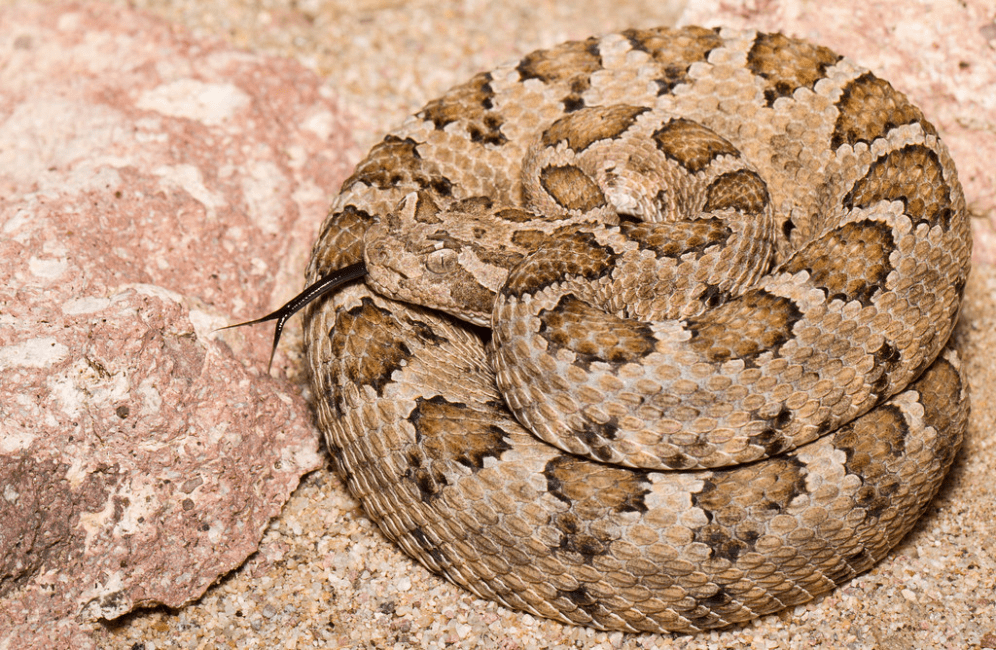
Found throughout the southern and central parts of the Baja California Peninsula, the Baja California rattlesnake (Crotalus enyo) is a small pit viper that mostly lives in desert environments.
Baja California rattlesnakes are mostly grey and light brown in color, but they have large brown scale patches along their backs. Although they share a range with a number of other rattlesnakes, including the red diamond rattler, the Baja California rattlesnake is fairly easy to distinguish using its coloration alone.
The IUCN lists the Baja California rattlesnake as a species of least concern with a stable population. However, its main threat is the expansion of agriculture, which is leading to habitat loss throughout its range.
19. Great Basin Rattlesnake
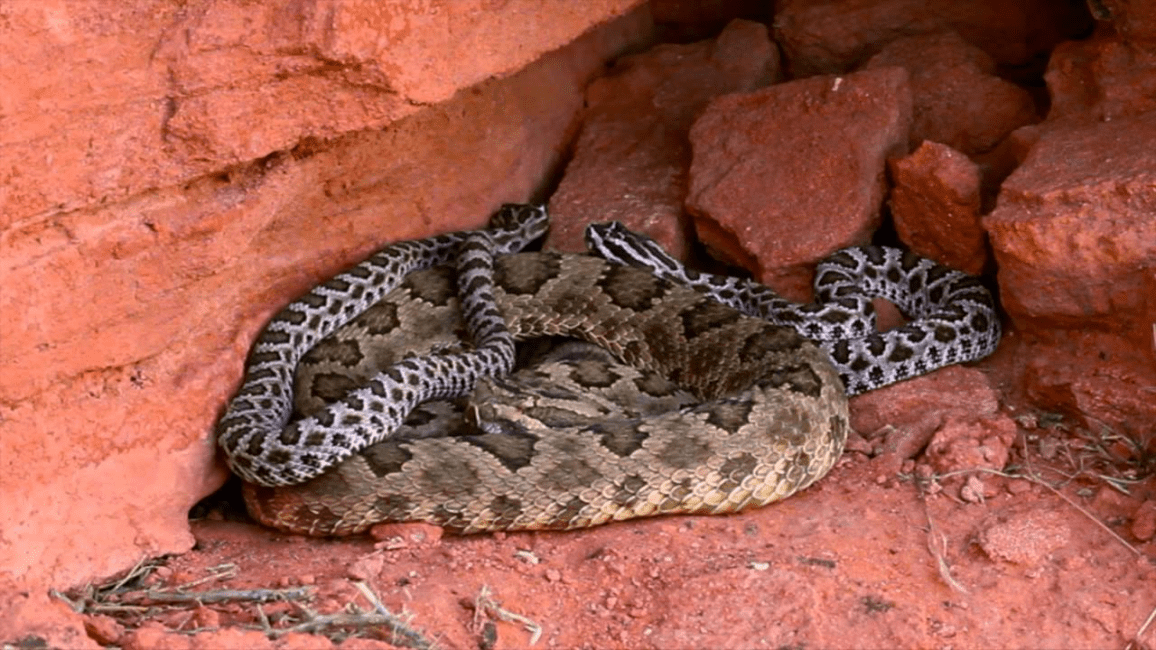
The Great Basin rattlesnake (Crotalus lutosus) lives throughout its namesake Great Basin, which is a huge physiographic region that covers most of Nevada and parts of California, Utah, Arizona, and Idaho.
It has a brown to buff color with a row of brownish blotches down its backside. However, the Great Basin rattlesnake is not to be confused with the Great Basin gopher snake, which lives in the same region but is not venomous to humans.
The Great Basin rattlesnake is not listed by the IUCN, perhaps due to some debate over its taxonomic relationship to the Grand Canyon rattlesnake (Crotalus organus abysus), whose range is located nearby. However, it is protected at the state level in Utah alongside all other rattlesnakes.
Read Also: The Appearance and Features of Rat Snakes
20. Massasauga

Featuring a captivating coloration and a huge natural range, the massasauga (Sistrurus catenatus) is a medium-sized pit viper that lives throughout central North America. It’s primarily found in the south-central United States and northern Mexico, but it also lives in the eastern Midwest and in southern Ontario.
Most massasaugas boast a grayish-white body with large rounded blotches of black scales. However, researchers have recorded a number of melanistic massasaugas with an all-black body.
Due to its large range, the IUCN lists the massasauga as a species of least concern. However, it is endangered or threatened on the state and provincial level in the northern part of its range. The species’ primary threat is habitat loss, which is particularly prevalent in the high-population-density areas of the northeastern United States.
21. Pygmy Rattlesnake
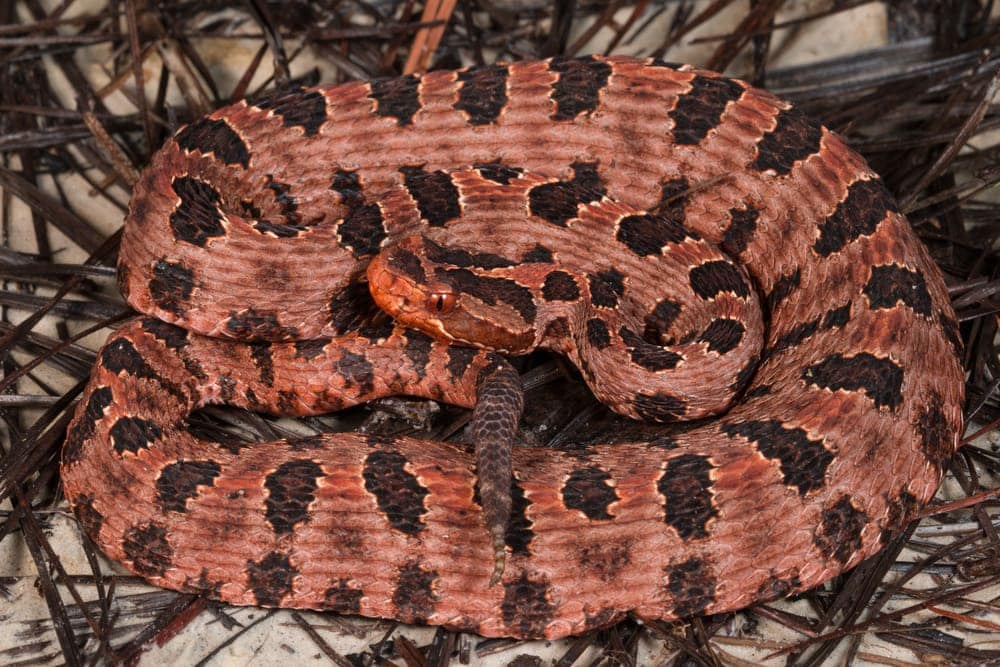
Last but not least, we have the pygmy rattlesnake (Sistrurus miliarius). As you can gather from its name, the pygmy rattlesnake is a particularly small pit viper. In fact, it rarely grows to be more than 24 inches (60 cm) long.
There are 3 recognized subspecies of the pygmy rattlesnake, all of which are endemic to the southeastern US. Most pygmy rattlesnakes live in forested environments, but they’re also just as at home in marshes and floodplains.
Although the pygmy rattlesnake has a highly toxic venom, its small size means that it rarely produces enough venom in a single bite to be fatal to humans. Nevertheless, anyone who gets bitten by a pygmy rattlesnake should seek out medical attention as soon as possible.
Read Also: Top 20 Proven Benefits of Ginger Plant






